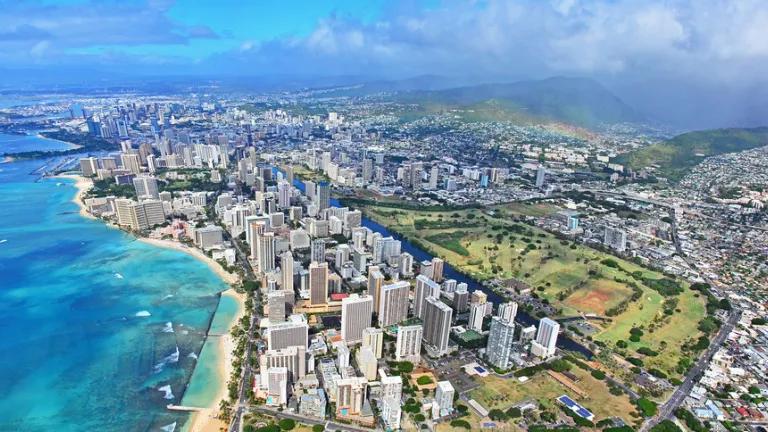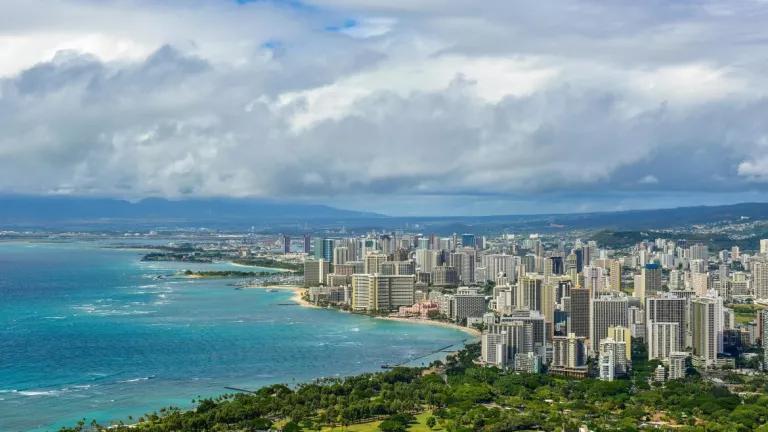Honolulu's New Climate Laws Will Save Energy and Money
Honolulu Mayor Kirk Caldwell today signed a long-awaited package of climate legislation that will help reduce carbon emissions and save money for residents and the City. The three bills address parking requirements, the role of the resilience office and “benchmarking” city building energy use, and solar power on multifamily buildings.

Honolulu Mayor Kirk Caldwell today signed a long-awaited package of climate legislation that will help reduce carbon emissions and save money for residents and the City. The three bills address parking requirements, the role of the resilience office and “benchmarking” city building energy use, and solar power on multifamily buildings.
Honolulu faces clear threats from climate change, from sea level rise to more severe storms to coral bleaching. Residents know this, and overwhelmingly support local action on climate.
Honolulu is on a roll
The bills just signed by Mayor Caldwell are part of a year-plus of action on climate by Honolulu, supported by the Bloomberg Philanthropies American Cities Climate Challenge.
Earlier this year, the City passed a climate-friendly energy code, which required new homes to be so energy efficient they will cut monthly bills in half, with roofs ready to install solar panels and some parking ready to charge electric vehicles. The City has also made a major push on climate-friendly transportation, rolling out new protected bike lanes and just launched a new bus-only lane on King Street, its first in decades, to speed sustainable, equitable transportation.
Like the energy code, two of the bills the Mayor just signed into law were supported by the Climate Challenge: Bill 2 and Bill 65. Local NRDC Action Fund supporters were very active in supporting these bills as well, as were local community groups, including Blue Planet Foundation, Faith Action for Community Equity, Sierra Club of Hawai'i, AARP, and Blue Zones Project Hawai'i.
More affordable homes, less paving of paradise
Bill 2 updates Honolulu’s parking requirements, removing the requirement to build a minimum number of parking stalls as part of each new development. Getting rid of minimum parking requirements is a proven climate solution: it significantly reduces driving and carbon emissions while prioritizing more sustainable transportation options.
Right-sizing parking also makes homes more affordable. Parking is extremely expensive to build. Before Bill 2, every new home had to include a minimum number of parking spaces, whether or not the residents even own a car. Removing the minimum parking required with any new home lowers the costs of that home both for developers and for prospective renters and homeowners.
Bill 2 had originally included additional people-friendly provisions such as requiring “unbundling,” or separating the cost of parking from the rent or mortgage of a home. In the bill that passed, unbundling is allowed but not required. Developers were able to make several similar changes to the bill, such as removing the requirement to set back parking from the sidewalk and provide more room for trees. The City Council made repeated concessions to developers, even as dozens of local residents and environmental and housing advocates speaking up for a strong bill at each of its many hearings over months. The process was flawed, but the advocacy from local groups was inspiring; the result is still a meaningful step forward.
Bill 2 updates parking requirements in one of the most broadly applicable ordinances of its kind in the nation, applying to the entire million-resident island of O'ahu. It will help create a more walkable island, with more homes people can afford. Its passage is a victory for sustainable transportation and the climate.
Saving energy and building resilience
Bill 65 strengthens the city’s climate work and the role of the City’s Office of Climate Change, Sustainability and Resiliency, which was brought into existence by voters in 2016.
The bill includes a municipal energy benchmarking program, which will enable the City to track and manage energy performance in City-owned buildings, over time reducing energy use and costs—and saving an estimated $7 million in City and taxpayer dollars over the coming decade.
The bill also sets the City on a path to create and adopt its first Climate Action Plan. This plan will likely include many important initiatives to fight climate change, among them a community-wide benchmarking effort to track energy use and help building owners manage and lower utility bills for properties all across Honolulu.
Developers sought to weaken Bill 65 as well, and for a time seemed to have succeeded. However, climate advocates spoke up to strengthen it, Councilmember Joey Manahan restored key provisions, and the full Council unanimously approved a strong bill to enable meaningful action on climate.
Bill 65 includes many other components as well, notably an innovative One Water policy to plan for resilient, coordinated water systems across the community. More on Bill 65 can be found at the website of Honolulu’s resilience office.
Good news from 2020
Along with Bills 2 and 65, Mayor Caldwell also signed Bill 58, which makes it easier to install solar panels on multifamily buildings, giving apartment and condo residents easier access to clean, low-cost power.
These actions add up. The bill signing comes just after the recent launch of several Climate Challenge-supported transportation improvements by Mayor Caldwell's administration—including a new bus-only lane on King Street, the City's first electric bus, and a new bike lane. Despite a very difficult year, Honolulu has made impressive strides on climate and on affordable housing and transportation.
The signing of these bills marks real progress toward a more truly resilient future for O'ahu and all its residents.
We look forward to more climate action from Honolulu's new mayor and his administration in the year to come.



